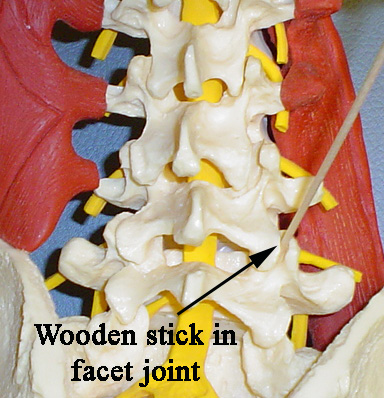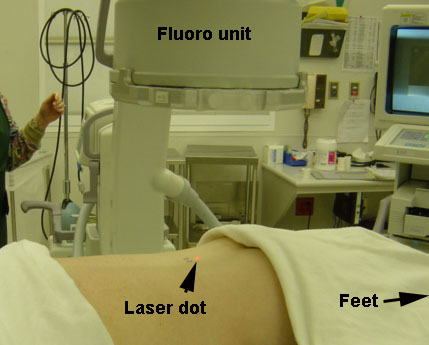The facet joints are the joints on the back side of the spine. These joints, which are covered with cartilage on the part where one side contacts the other, can have that cartilage wear out, become rough, and be a source of pain.
Injecting these joints can give significant relief, like injecting an arthritic knee


On this model, a wooden stick here represents a needle, which under xray guidance, can be placed into the facet joint where a small amount of local anesthetic and some steroid can be injected.

As with the epidural injections, the placement of the needle is assisted with fluoroscopic imaging, which is a real-time x-ray machine that can take instant x-ray pictures. The patient is usually face down on the table, and the fluoro unit has a guiding laser light. A metal object, in this case below on the right, a surgical clamp, can be placed on the laser dot so that the needle can be directed into precisely the right location.


As shown on this xray (fluoroscopic) image, the needle can be seen in the facet joint.
These injections are important for both diagnosis and for treatment. If, for example, there is question of whether the pain is from facets or disc, these injections can be performed.
If the pain is relieved by injecting certain joints, then those joints are likely contributing to the pain generation.
In a successful injection, it is not uncommon to have relief lasts several weeks or sometimes for months. The steroid (cortisone type medicine) injected usually starts working at 2-4 days after the injection.
If the facets are identified as the potential source of pain, there is another treatment that can become a viable option: radiofrequency ablation.
This procedure (also referred to as RFA), which is done with a needle (i.e, it’s not a cutting type of surgery), can provide pain relief for between 6-12 months. The procedure does not remove the arthritis of the joints, but there is less pain felt from the arthritic joints. As with any procedure that makes the symptoms more tolerable, most patients would rate the procedure as a success to have less pain.
We can offer a number of treatments that are referred to as interventional pain management, including treatments for facet joints. These treatments, in case you hear these terms or see them in your medical record, include
Epidural injections (introducing medicine around the nerves)
Facet injections (introducing some medicine into the small joints on the back of the spine)
Medial branch blocks (do the same thing as facet injections by blocking the nerves to the facet joints, when there is too much arthritis in the facet to introduce a needle)
Radiofrequency ablation (burning the small nerves that go to the facet joints)
